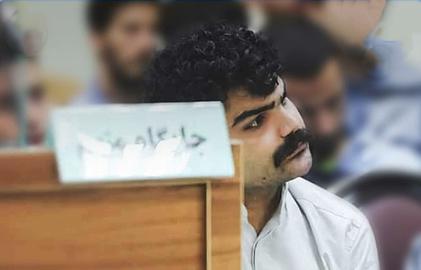
The cover of one the last issues of Ham Mihan, one of the three publications shut down
A new president, supported by reformists, has taken power. Yet in the past two months, authorities have shut down three reformist publications in rapid succession. This may seem to bode poorly for prospects of press freedom under President Hassan Rouhani, but the background to the closures suggests they are less about this new era than a hangover from the last election that brought the new president to power.
Permission to publish in Iran can be revoked by a branch of the judiciary commonly known as the “Press Court.” The country's judiciary, which is largely run by conservatives appointed by the Iranian Supreme Leader Ayatollah Ali Khamenei, follows his wishes, whether they are expressed implicitly or explicitly. Sadeq Larijani, Iran's current Chief Justice, has stated that the government does not derive its legitimacy from the votes of the people. He was also a vocal critic of the reformist president Mohammad Khatami, who took office in 1997.
Mashallah Shamsolvaezin, editor of Neshat, one of the closed newspapers, regards Larijani as being responsible for the closure. “The Supreme Court had decided that there were no legal barriers against the publication of Neshat,” he said, but “the assistant prosecutor sent a letter to the Ministry of Culture and Islamic guidance stating that His Honour the Chief of the Judiciary has intervened on the basis of Article 18 and, therefore, the publication of Neshat is not legally cleared.” Under Article 18 of the Iranian Civil Code, the Chief Justice is given wide latitude to decide civil cases.
Larijani’s name appears in the news in connection with other newspaper closures as well. In an October statement on the closure of the yet another newspaper, Bahar, he threatened that the judiciary would “react strongly” against those who “falsify history and try to weaken the foundations of our beliefs” by creating a movement against the Islamic system. He warned that forces similar to those that characterised the “reformist era” (meaning Khamenei’s presidency) want to use the press to question Islamic values.
“Poisonous Weeds”
Ayatollah Khamenei has advised conservatives and hardliners to leave the foreign policy to Rouhani, for the moment at least, and those most close to him have heeded his advice. For example, Ali Akbar Nateq Nouri, a conservative and the Inspector of Leader’s office, hailed the Geneva nuclear agreement as a “success” and chastised those hardliners who have called it “treason.”
On cultural and media issues, however, the opposite has been true. On December 10th, in a meeting of the High Council on Cultural Revolution, with Rouhani sitting next to him, Khamenei clearly rejected Rouhani’s promised cultural reforms. The Iranian president had recently stated that the government would reduce its interference in cultural affairs to a minimum and would allow people active in cultural fields to make many of the decisions. “Entrusting people with cultural matters,” he said, “does not negate the duty of the government to supervise and guide.” He also compared culture to a garden from which “poisonous weeds” must be uprooted.
Independent publications extend the influence of the new government, a reality that grates on hardliners. This is why the newspapers Tose’e, Neshat, and Ham Mihan had to suffer the fate of “poisonous weeds”, even though Ali Jannati, the new minister of Culture and Islamic Guidance, the government agency supposedly responsible for regulating the media, had talked about convincing the judiciary to change its mind.
“Enemy Bases” and “Stillborn Babies”
This heavy-handed conduct by the powerful judiciary dates back to the era of former president Khatami. His victory in 1997 ushered in a period of great media freedom unprecedented under the Islamic Republic, which came to be known as the Tehran Spring. But it was not to last. In May 2000, Ayatollah Khamenei branded the reformist press as “enemy bases,” prompting Saeed Mortazavi, prosecutor of the Press Court at the time, to shut down about 60 publications and acquire for himself the nickname of “Press Murderer.”
Later that same year, in August 2000, Khamenei ordered Mehdi Karroubi, the speaker of the parliament at the time (now held under house arrest since the aftermath of the 2009 elections), to remove the bill to reform press laws from the roster of the reformist-dominated legislature. These two events sharply reduced the presence of reformists in the media landscape.
Rouhani, of course, is not Khatami, and he tends to describe himself as a centrist, not a reformist. As we have seen, Khamenei and his circle have endorsed his foreign policy. But he owes some share of his victory to the support of Khatami, including the fact the Khatami persuaded one his competitors to drop out of the electoral race. Add to this the support of the former president Hashemi Rafsanjani, and you have a convergence that is bound to create high anxiety for both the Supreme Leader and the judiciary, neither of whom wants to see a popular independent process institutionalised.
“We should not mince words,” says Shamsolvaezin. “The opposite faction is very sensitive to the fact that a bunch of Khatami-era journalists have gathered to launch a publication with a provocative name such as Neshat (which translates as “joy” or “happiness”)." “This is the real reason, not the pseudo-legal excuses that they have offered.”
According to a media expert, it's important to be aware of powerful hardliners' “thin skins”. They have not responded well to the reappearance of Khatami-era figures they detest. Already they are warning against “the creeping activities of sedition” as the conservative website Dana calls it. The site also warns that the “conspirators” of the disputed 2009 elections want to stage a “coup d’état” within Rouhani’s administration.
It seems that under present conditions Rouhani’s administration lacks either the inclination or the ability to open up the press environment. Considering the powerful opposition of Khamenei and the judiciary, this should not come as a surprise. The question is whether the power equation will change and, if so, when. For the moment many journalists in Iran feel bitter and discouraged.
As Shamsolvaezin puts is, after toiling for months “it was like having a stillborn baby!”
visit the accountability section
In this section of Iran Wire, you can contact the officials and launch your campaign for various problems
























comments